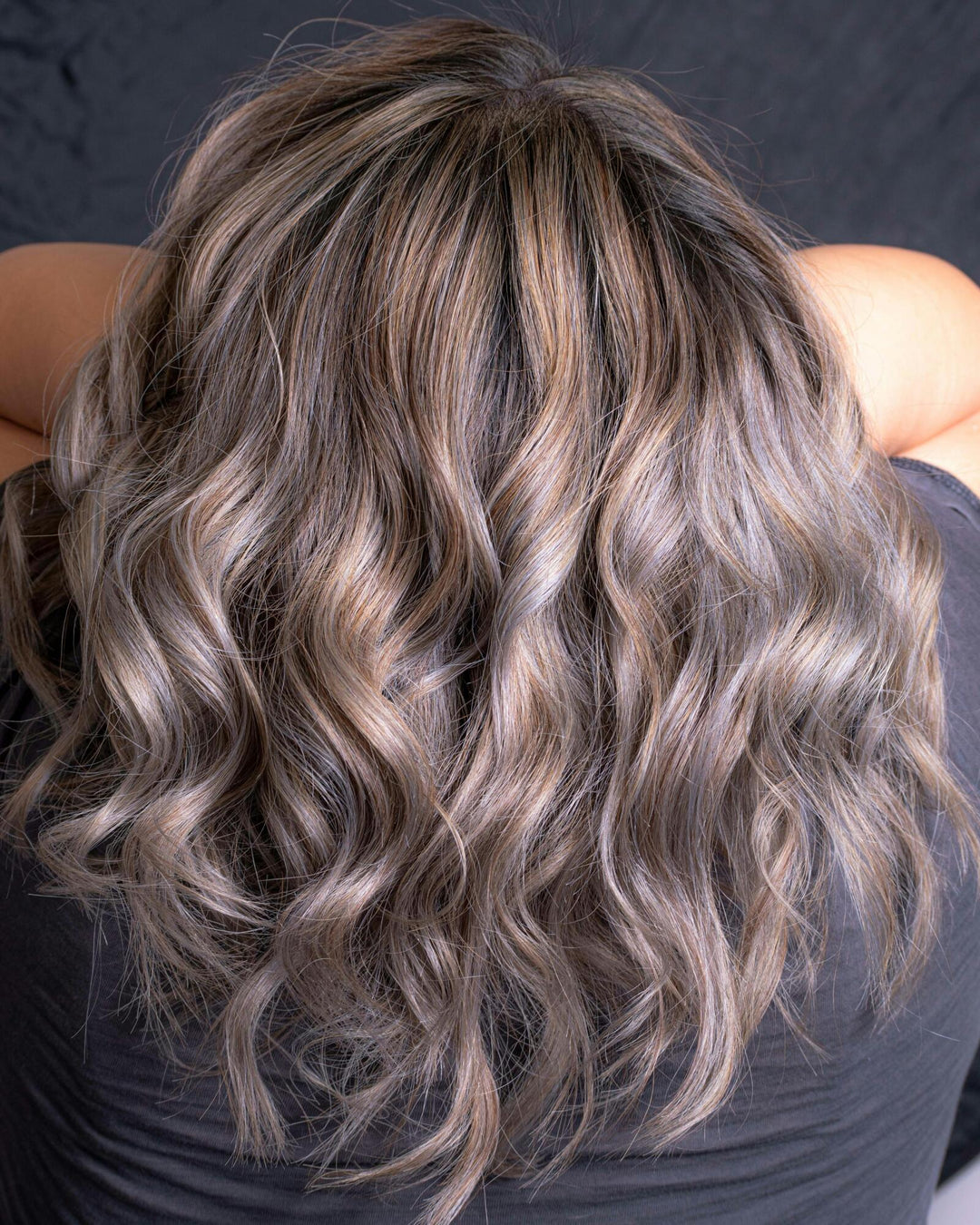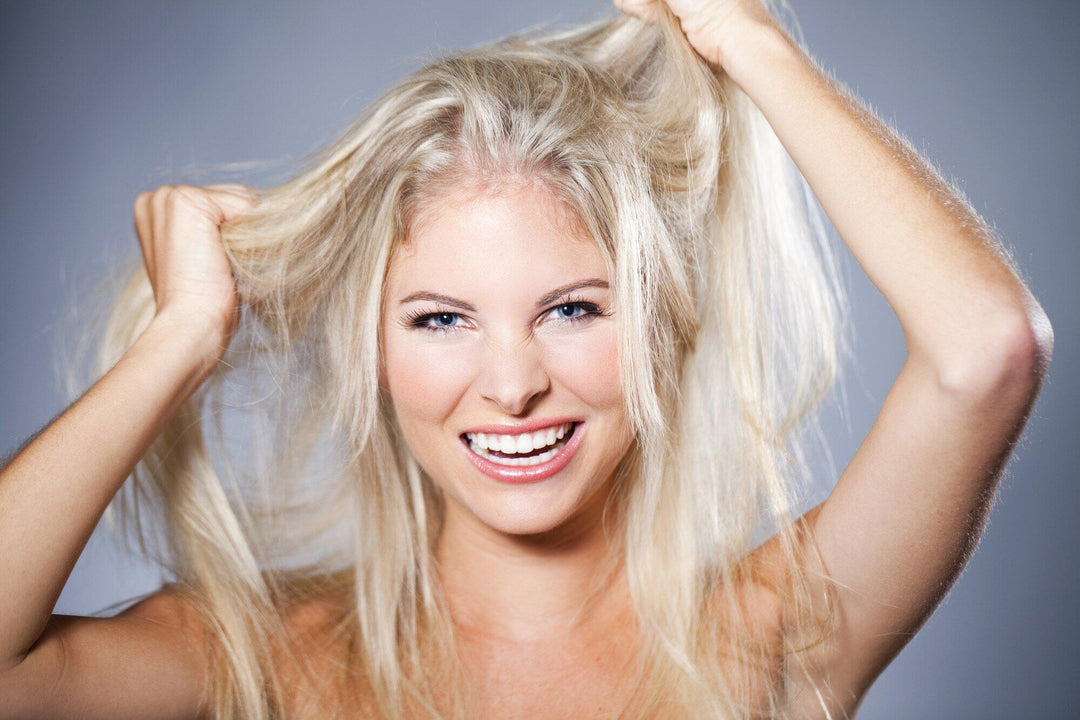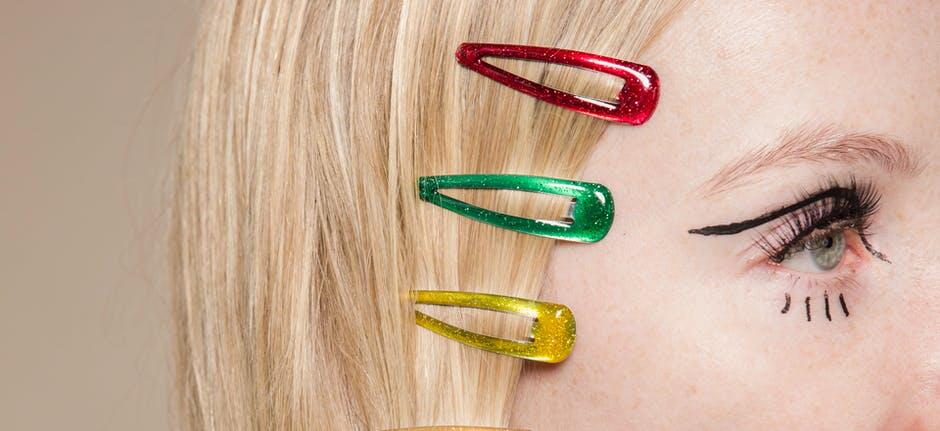For women, hair loss can be devastating. Hair that was once our crowning glory becomes a source of stress and embarrassment. But while some hair loss is genetic and can be difficult to reverse, many causes of hair loss can be treated. These include nutrient deficiencies, lifestyle habits, medical conditions, stress, and hormonal changes. In addition, there are ever more ways to disguise and cosmetically camouflage hair loss that can be quite effective. So, there is plenty of reason for hope.
But first, let’s start with a definition: According to the American Academy of Dermatology, all of us shed hair every day, and you shouldn’t worry about losing 50-100 hairs per day – it’s normal. Hair growth is a cycle and hair falls out and regrows regularly. But if you’re shedding more than 100 hairs per day, you will probably start to notice the telltale signs of thinning hair: a widening part, sparser spots on your scalp, or stubborn cowlicks that you can no longer cover. At that point, it’s time to determine the causes and put some treatment options on the table.
Since most hair thinning happens gradually, you probably have time to figure it out. Thinning hair can often grow back if you are able to pinpoint the causes and address them. If you notice sudden thinning, or you’re losing hair in clumps or patches, you should consult your doctor to make sure that you don’t have an underlying medical condition that is causing it.
With that caveat, let’s talk about some of the most common causes for thinning hair.
What Causes Thinning Hair
Heredity
According to a 2019 article published by Harvard Medical School, four in ten people will experience genetically based hair loss. In men, it’s known as hereditary pattern baldness affecting the hairline and the middle of the head. But for women, hereditary hair loss is often more diffuse and widespread. Hereditary hair loss, while not completely reversible can definitely be slowed down. Regardless of whether it develops in a man or woman, the medical term is androgenic alopecia and it means that you’re genetically predisposed to hair follicles –which anchor hair to your scalp -- that shrink and eventually stop growing hair. Shrinking can begin as early as your teens but tends to start later in life.
In women, the first noticeable sign of hereditary hair loss is usually overall thinning or a widening part that reveals more of your scalp than you’d like to see. But don’t lose hope, there are treatments that we will discuss later.
Lifestyle factors
Lifestyle factors can have a bigger impact on hair loss than you might think. In particular:
- Over-treating your hair with color, perms and relaxers can cause thinning. But also, using harsh hair products such as extreme-hold hair sprays and gels can cause you to literally tear your hair out. Your scalp and hair follicles can only take so much abuse until they rebel with falling hair. Ladies, you know who you are.
- Teasing: Teasing is just a fancy way of saying that you are tying knots in your hair. And when you try to comb those knots out, you pull out hair too. If your hair is already thinning, regular teasing and the resulting hair pulling will make it look even thinner. And if you damage the follicles, the hair won’t grow back.
- Tight Hairstyles: If you’re constantly pulling your hair up into a tight ponytail or an updo for working, working out, or sleeping, that means that your hair follicles are experiencing constant tension, which will cause hair to thin over time. The medical name for this is traction alopecia and it can lead to permanent hair loss if it continues.
- Extreme weight loss over a short period of time can also wreak havoc on your hair and scalp.
- Eating disorders such as anorexia and bulimia can alter your body’s delicate chemical balance and cause hair to shed.
- If you’ve recently undergone an operation or are recovering from an illness, you may experience temporary hair loss.
- Experiencing chronic stress: Stress is related to a rise in hormones like cortisol which may kill off vulnerable new hairs before they have a chance to grow. If you don’t get that stressor under control, your hair shedding will continue.
Hormonal/Nutritional and Medical Factors
- Post-birth: Many women notice extreme shedding that starts about two months after childbirth and peaks at four months postpartum. This is normal but can feel like you’re losing all your hair! Just know that it is temporary and will stop when hormones normalize after about six to nine months.
- Menopause: The hormonal changes of menopause cause hair loss in most women of a certain age. In fact, age itself causes hair loss in almost everyone, eventually. As we age, the rate of hair growth slows and nutrient absorption diminishes. Hair strands become more brittle, thinner and less pigmented. Eventually many hair follicles just stop new hair production.
- Birth control pills: Many women notice excessive shedding when they stop taking birth control pills.
- Autoimmune deficiencies as well as treatments for autoimmune diseases can cause hair fallout. For example, alopecia areata is a disease that develops when the body’s immune system attacks hair follicles (what holds the hair in place), causing hair loss.
-
Nutritional deficiencies including Vitamin D, Folic Acid, iron and certain minerals can cause hair loss and interfere with the follicles’ natural hair growth as can too little biotin, iron, protein, or zinc. If you’re not getting enough of one or more of these, you can have noticeable hair loss.
- Skin disorders and infections can affect the scalp and cause hair loss.
- Thyroid issues including both hypo- and hyper-thyroidism can lead to hair loss and it’s wise to check with your doctor to request a thyroid test if it’s excessive.
Remedies for Thinning Hair
Now that we’ve discussed the causes, let’s get to the fun stuff: the solutions that can treat or mitigate the appearance of thinning hair.
Medication and Clinical Treatments
There are a couple of clinically proven treatments for hereditary hair loss that will slow down shedding significantly and even thicken hair over time.
Minoxidil:
Also known as Rogaine, Minoxidil is an over-the-counter solution you apply twice-daily to your scalp. It works by increasing blood circulation to the affected area of your scalp, thickening and strengthening the hair follicles. This medication is available as a topical solution or a foam. Scientists think that this medication works by increasing capillary blood flow to the follicle and allowing hair to stay in the growth phase for longer. A clinical study by the brand found that 80% of women experienced hair growth.
Results usually show after four to eight months of application, so you need to be patient. The sooner you start these medications after you notice your hair shedding, the more effective they will be. But, you need to be extremely disciplined when using these treatments and use them daily as prescribed. If you use them exactly as prescribed, they work extremely well. But if you are not disciplined about using them and miss doses because they are messy or uncomfortable on the scalp, they won’t work. Compliance is the key.
Spironolactane (Aldactone):
This treatment is sometimes prescribed for people who have thinning hair related to an overproduction of male hormones. Aldactone isn’t approved specifically for hair loss and is considered an off-label treatment option. While technically a diuretic or “water pill,” Aldactone is an anti-androgen, too. In women, this medication may help treat thinning hair and subsequent hair loss related to hormonal fluctuations. It won’t grow new hair but can help thinning hairs become thicker and fuller. A simple blood test can determine if you’re a candidate for this treatment.
PRP (Platelet-Rich Plasma):
Doctors are continually researching new techniques to restore hair growth. One example is platelet-rich plasma (PRP) treatment. This involves separating the platelets from a sample of a person’s blood using a specialized machine, then injecting these platelets into areas of the scalp affected by hair loss.
Doctors believe the platelets contain a significant amount of growth factors, which can help stimulate hair growth. One study found that women who received PRP injections saw increases in the density and thickness of their hair after 6 months. However, more studies need be done to prove PRP’s effectiveness.
Nutritional Treatments
Healthy hair is dependent on your overall good health. In cases of malnourishment or with certain eating disorders, new hair may fail to generate from follicles. A blood test can help determine if you have a nutrient deficiency. For the most part, you should try to get your nutrients from your food, as they are most readily absorbed in that form. Micronutrients in a healthy diet are also essential to growing new hair and keeping what you have.
There are many foods that have been associated with hair health: First of all, make sure you’re getting enough protein. Eggs are a great source and also contain biotin which may boost growth (though more study on this is needed.) Protein is essential to the follicle growth cycle and without enough of it, hair can look brittle, dull and dry. Certain amino acids in protein-rich foods may help promote hair growth, such as L-lysine. L-lysine is also present in the hair’s root, and it is responsible for the shape and volume of the hair. It is contained in meat, eggs, beans, lentils and nuts.
Brazil nuts are a source of selenium, a mineral that may improve hair health. Fatty fish and walnuts contain hair-healthy Omega-3 oils. And don’t forget your Vitamin D which is necessary for stimulating follicle growth and is contained in fatty fish, beef liver, cheese, egg yolks, mushrooms and fortified foods such as milks, cereals and juices.
If a blood test indicates that you are low in several key areas, your doctor might recommend vitamin supplements. Healthy hair needs iron, folic acid, and zinc to keep growing thick and strong. Biotin, or vitamin B-7, is a water-soluble nutrient that’s naturally found in foods, such as nuts, lentils and liver. You should already be getting enough of it if you have a balanced diet, but supplemental biotin has been popular the last few years promising better hair growth and more energy, although clinical evidence is scarce.
Omega-3 and Omega-6 fatty acids are called essential fatty acids because they can’t be made by the human body. Omega-3 helps to fight inflammation, which is an underlying cause of many conditions including hair loss, while Omega-6 might benefit the scalp. Plant-based oils are primary sources of Omega-6, while Omega-3 fatty acids are found in fish and some seeds. If you don’t normally consume such foods, talk with your doctor about taking a supplement.
Deficiencies in any of these nutrients may be associated with some types of hair loss. But be careful not to overdo it. There isn’t any evidence that getting too much of a good thing will help to reverse hair loss. In fact, it may do more harm than good.
Home Treatments
Scalp Massage:
Regular scalp massage can be surprisingly effective as it brings blood flow and nutrients to the hair follicles. It’s also the cheapest treatment available and feels wonderful! Gently apply pressure with your fingertips around your scalp or use a handheld scalp massager to improve circulation and remove dead skin cells that can clog follicles and prevent new growth. Scalp massage is believed to work by stretching the cells of hair follicles to produce thicker hair and dilating blood vessels beneath the skin, encouraging growth. A daily 5 minute massage will give the best results, which may take up to 6 months to see.
Hair Supplements:
There are several physician-formulated vitamin supplements designed to support the hair growth cycle that many women swear by, though clinical evidence is limited. These can contain DHT (dihydroxy testosterone) inhibitors and anti-stress adaptogens, anti-inflammatories and antioxidants, as well as vitamins, minerals and amino acids that support hair building blocks. Best results are seen over a several months, so you have to be consistent.
Thickening Shampoos and Treatments:
Hair thickening shampoos work by not only cleaning the scalp, but also by containing ingredients that can coat individual hairs and give them a thicker appearance. Some also temporarily fortify the strength and rigidity of individual hairs lifting them away from the scalp, which gives the appearance of thicker hair. Ingredients to look for include hydrolyzed wheat protein that makes hair shine and improves the body of hair while helping protect it from damage by forming a film on the hair shaft. Rice protein also builds volume and adds weightless moisture.
Scalp and Hair Treatments:
These products contain ingredients such as vitamins and amino acids that promote scalp health and hair growth. Most work by removing debris that clog hair follicles and also contain scalp-healthy nutrients and DHT (dihydroxy testosterone) blockers. Ingredients to look for include tea tree oil to dissolve sebum build-up, caffeine which stimulates hair follicles, green tea which strengthens them, as well as pumpkin seed and rosemary oil which work as natural DHT (dihydrotestosterone) blockers. Rosemary oil has also recently come to the attention of dermatologists for its ability to stimulate blood flow in the scalp and is an increasingly popular ingredient in shampoos, conditioners and scalp treatments. To get the best results, use these products as directed. Because thinning hair can happen for a number of different reasons, you might have to go through a trial-and-error period to find the shampoo or treatment that works best for you.
Prescription-strength shampoo for thinning hair is also an option that you can speak with your doctor about.
Hair Styling Gels, Mousses and Pastes:
There are many styling products in various forms – gels, sprays, mousses, and pastes – that deposit material onto your hair making it feel temporarily more thick or dense. And while these have their place as styling aids to make hair stand up temporarily, the heavier ones weigh hair down and cause it to feel sticky and gunky. These products can also end up clogging hair follicles aggravating already thinning hair. These are short term fixes at best, so use sparingly as they can be cause even more thinning if overused.
Hair Volumizing Irons:

Another way to give the appearance of much thicker hair is with a new type of hair tool, the hair volumizing iron, a breakthrough for fine or thinning hair. Pioneered by VOLOOM, this iron features heated checkerboard plates that create structure in the underlayers of the hair lifting it up and away from the scalp, giving the appearance of much greater hair volume. A single use of this tool, which just takes minutes, creates volume that lasts for days. This is especially important for women with thinning hair who tend to wash their hair too often, not because it’s dirty, but to give it some lift. Going longer between shampoos (while maintaining a voluminous look) has many hair-healthy benefits. There is less use of harsh detergents and chemicals, less blow-drying, less heat styling, and even less coloring – all of which can damage fragile thinning hair. And VOLOOM is used only on the hair nearest the scalp, with its own natural oils and “heat protection.” It is never pulled through the fragile ends like other heated tools so it is not damaging to hair. Women find that their hair gets healthier over time by using the tool and can look like it has 2 to 3 times more volume. It may be a thin haired gal’s best friend.
Home Laser Therapy
Laser therapy is typically used by dermatologists and other skin specialists, although the FDA has cleared the way for some products to be used at home. At-home laser therapy for hair is intended to help regrow your hair while also making it thicker. The results can take several months to take effect so if patience isn’t your strong suit, it may not be for you. The biggest drawback of at-home laser therapy is the cost. Some devices are sold for thousands of dollars, and they may not work. Talk with your doctor before making such a large investment.
The Net Net:
While thinning hair is certainly distressing, don’t lose heart. Many causes of hair thinning are treatable. And there are many options for making the strands you have appear thicker and more voluminous such as volumizing shampoos, conditioners and treatments as well as hair tools such as the VOLOOM Hair Volumizing Iron which give the appearance of much greater hair volume.
If you’re experiencing new hair loss or hair thinning, or if your hair is falling out in patches and you’re developing bald spots, you should talk with a doctor. They can help you detect any underlying medical conditions, as well as offer any related medications.







